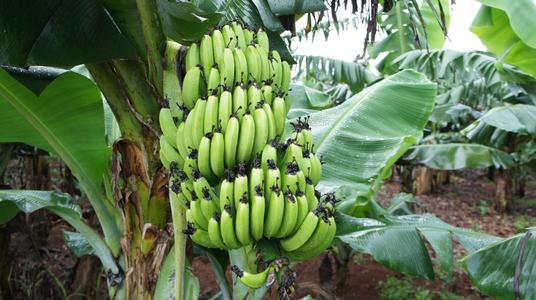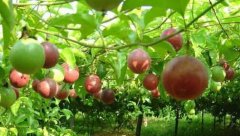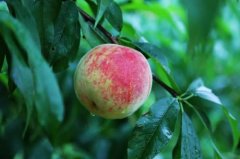Three common diseases of banana: black spot disease/thin stripe disease/dwarf disease
Banana common diseases small black spot disease, thin stripe disease, atrophy disease and prevention methods introduced, let's take a look at it!
small black spot disease
Pathogen: The optimum temperature for mycelium growth is 25℃, for spore formation is 13~29℃, and for spore germination is 13~33℃.
Symptoms: Mainly harmful to leaves and fruits, brown black or black small spots about 1mm in diameter appear on leaves, fruits or fruit shafts, similar to black spot, but the disease spot does not protrude.
Disease ecology and stage: It occurred more in dry season, no matter leaf age, young or old, disease spots appeared 4 days after inoculation, but the number of disease spots on young leaves was more.
Control methods: zinc-manganese-phosphate and tetrachlorophane had better control effect, followed by rot, and the effect of immunity was poor.
bacterial leaf streak
Symptoms: At the beginning of the disease, small brown spots appear on the back of the leaves, as thin as needles. Most of the small spots tend to gather and form patches or bands along the edge of the left half of the leaves. At the late stage, the lesion was parallel to the small veins and was thin, black, about 1~4mm long and 0.3 mm wide. Before heading banana plant, the disease spot generally appears in the old leaves below the 6th leaf, and the old leaves infected seriously quickly chlorosis and dry.
Pathogenic ecology: The incubation period of this disease is about one month in summer and about two months in winter. Except Musa cuminata belonging to AA group and wild banana in mountainous area of this province, other banana varieties will be infected. The spread of this disease may be closely related to insects.
Control methods: zinc manganese naipu, free Lai De and tetrachlorobenzene are effective control.
dwarf disease
Symptoms: The diseased banana plants are dwarfed, pseudostems are thin, leaves are narrow and erect, petioles are shortened, and leaves cluster at the top of pseudostems and are broom shaped. The new leaves are light green, the edges are white green, the leaves along the sides of the middle rib are thicker, the old leaves are dark green, and the tissues are fragile and easy to break. Petiole, veins and ribs have dark green intermittent lines. Disease banana plant often can not heading, if heading fruit axis and fruit finger is very small.
Disease original ecology: the vector insect is banana aphid, the banana aphid stays on the diseased plant to feed for 2 hours, can obtain the ability to infect the atrophy disease, and the poisonous aphid eats on the healthy banana plant for 2 hours, can infect the atrophy disease. The incubation period of this disease is about 30 to 70 days. In heavy rain season, the activity of banana aphid is limited, and the disease spreads slowly.
Rapid diagnostic technique: A small piece of tissue from the vein, leaf sheath pseudostem or corm of banana suckers, seedlings or mature plants is cut and observed directly with a reflective fluorescence microscope. A very obvious special strong yellow fluorescence reaction is easily seen in the sieve tube cells of the diseased plant tissue, indicating the existence of virus in the diseased tissue.
Period: All year.
Control methods:
1. Banana seedlings must be collected from disease-free banana gardens.
II. Extinguishing the diseased plants:
1. Pseudostem injection was carried out with 50-fold dilution of herbicide 41% carbophos solution. Inject one hole 50 cm above the ground, and then inject one hole every 100 cm. The injection time of each hole is about 3 seconds (100cc liquid medicine). Each injection hole is injected from different directions to prevent the liquid medicine from flowing out. When injected into the mother plant, carbophos can be transferred to the suckers and kill them.
2. Spraying or pouring kerosene on diseased plants can kill banana aphids on diseased plants and promote rot of diseased plants.
Large plant disease banana (more than 2 meters) each plant applied 300 grams of kerosene.
Medium plant disease banana (1~2 meters) each plant with kerosene 200 kg.
50~100 metric pinch of kerosene was applied to each plant of small diseased banana (less than 1 meter).
3. After kerosene treatment, the diseased plants begin to rot after 5~7 days, that is, even tubers are dug out, chopped and dried, and attention is paid not to make the diseased plants suck buds and grow again.
3. Eliminate other hosts of banana aphid near banana garden, such as peach and ginger flower.
4. If the disease worsens, spraying pesticides together, the pesticides for controlling aphids are 40.6% diluted with 800 times of water suspension powder and 40% diluted with 1500 times of rice pine.

- Prev

What is the reason why passion fruit only blossoms and does not bear fruit? Passion fruit needs pollination before it can bear fruit.
Why does passion fruit grow only blossom but not bear fruit? In August this year, I bought a passion fruit from a vendor in the vegetable market. After that, it blossomed one after another, but it didn't turn out that I was planted on my south balcony with soil more than two feet high.
- Next

When is the best time to bag peaches? How to thinning fruit and picking heart when bagging peaches
The bagging of peaches is divided into several parts, hoping to help farmers who grow peaches. Let's have a look! 1. Central region: because the cold spell is different every winter. The time of bagging is slightly different. Peach branches are usually cut at a fixed time. The older generation taught me in front of the Winter Solstice.
Related
- The first cup of black tea in spring, the flavor and history of tea gardens in Kenya, Africa
- The computer can not only choose potatoes, but also grow tea rice. AI will grow winter oolong tea champion.
- It is not only the inflated tea bitten by insects, but also engraved with the four seasons tea in Beipu.
- The Oriental Beauty Tea Festival in Zhuxian County takes the stage at the weekend to experience the plus-size feast of oil tea.
- & quot; Oriental Beauty Tea & Exploration of Emei in Hsinchu, the hometown of quot;
- The new variety of strawberry "Tainong 1" dessert is the first choice with mellow aroma. Crimson gorgeous
- History of Tea in Taiwan: from Wild Inner Mountain to Export Tea Garden
- Two types of Taiwan Oriental Beauty Black Tea won the British three-Star Award for Childhood Tea Xiang Zhang Jiaqi changed from pilot to champion tea maker.
- Banana species and varieties: the planting history of Taiwan Xianren banana and dwarf banana is long, is banana disease resistant?
- Coffee planting Technology: Qianjie Coffee from Seedling to harvesting

